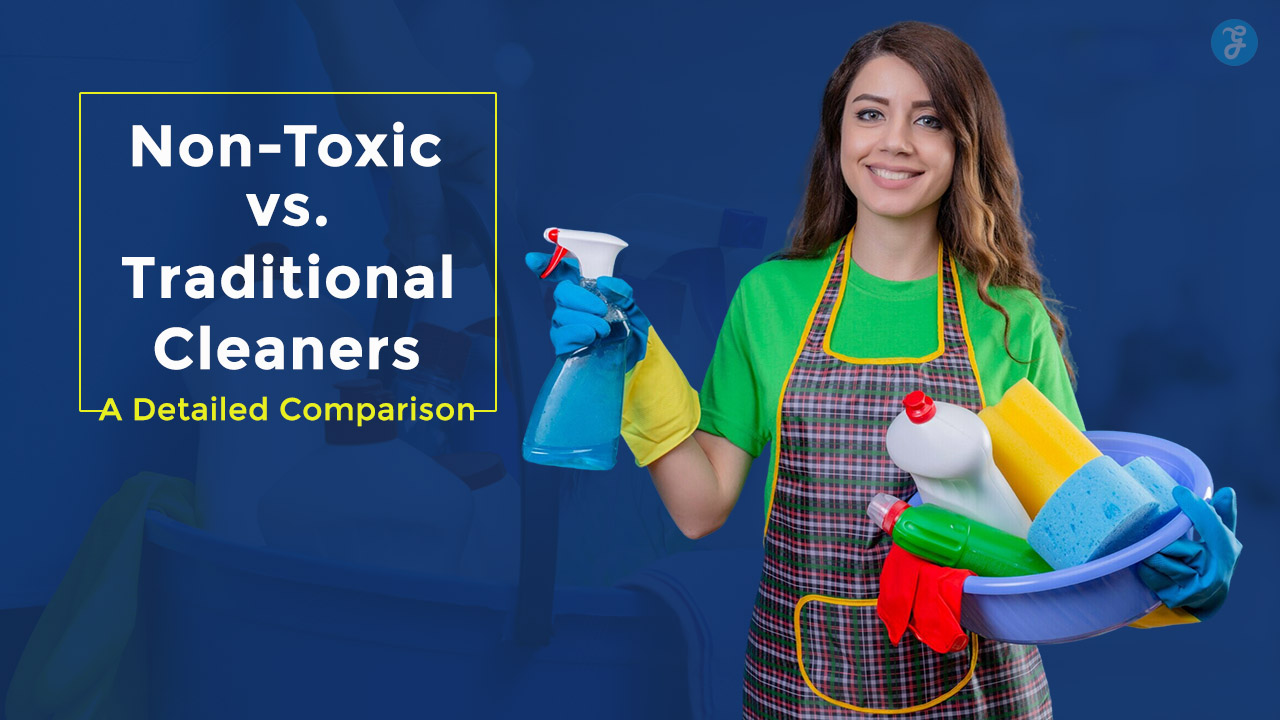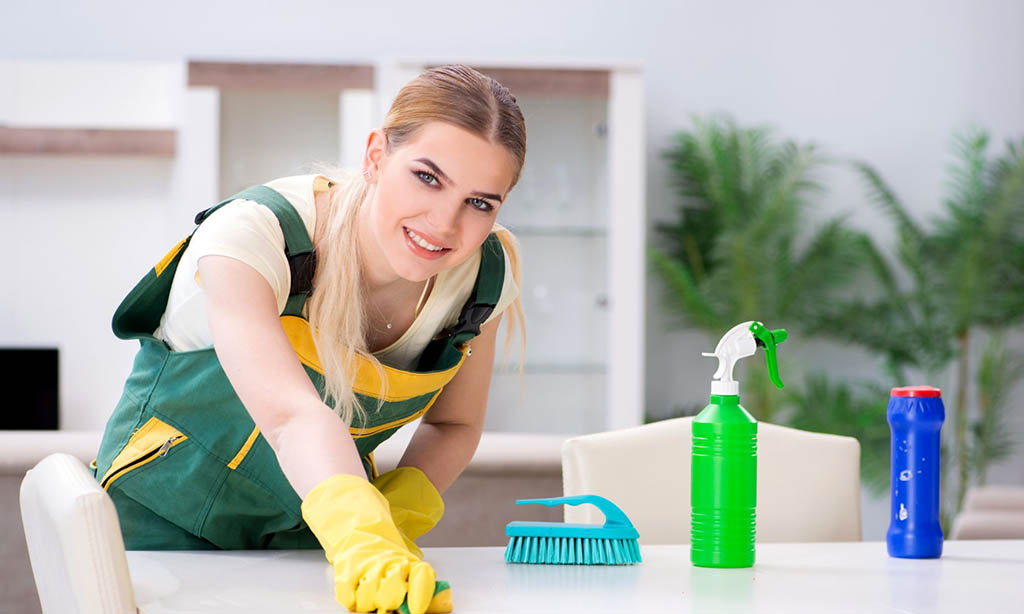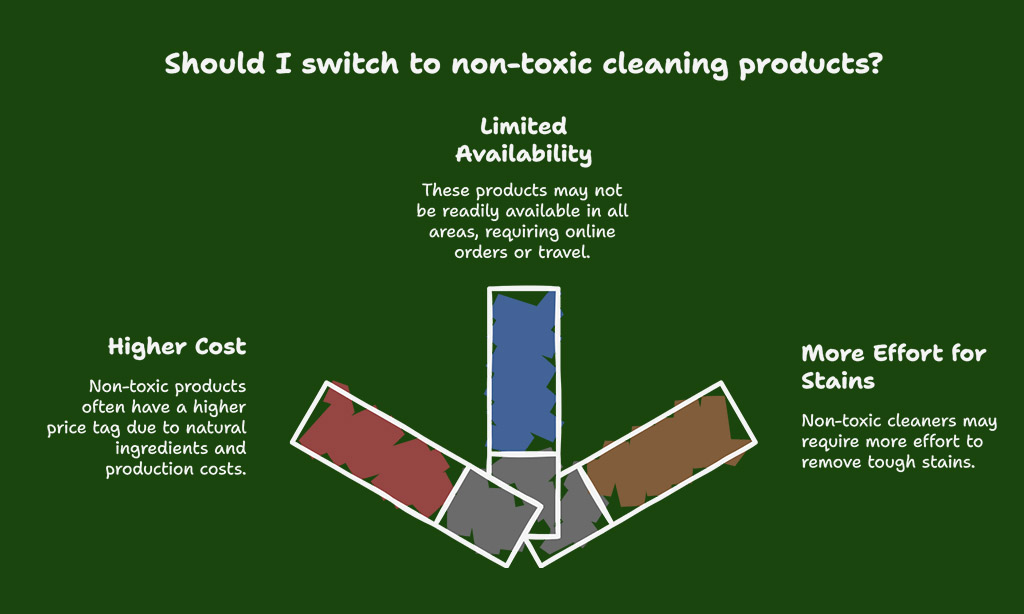Hey there, have you ever grabbed a bottle of cleaner, sprayed it around your home, and then wondered what’s really in that stuff? Many of us clean our spaces without a second thought, but those harsh chemicals in traditional cleaning products can mess with our air quality, our health, and even our pets.
It’s a sneaky problem, hiding right under our noses in something as simple as dish soap or laundry detergent.
Here’s a startling fact, folks. Out of about 62,000 chemicals approved for use in the U.S., the government has only tested around 300 for safety. That’s a tiny drop in a huge bucket, leaving us to wonder what’s in our all-purpose cleaner or glass cleaner, and how it impacts our indoor air quality.
Stick with me, because I’ve done the hard work of digging into non-toxic cleaning products versus the old-school chemical cleaners. I’ve spent weeks checking out options at places like Target, comparing environmental impact, and looking at ratings from groups like the Environmental Working Group.
This post will break it down, showing you the perks of going green with eco-friendly cleaning, and helping you pick safer stuff for your home. Ready for a cleaner, healthier space? Let’s go!
Key Takeaways
- Non-toxic cleaners use natural ingredients like vinegar and lemon, unlike traditional cleaners with harsh chemicals like ammonia and chlorine bleach.
- About 53% of traditional cleaning products have ingredients that harm lungs, as per EWG ratings.
- Around 22% of traditional cleaners are linked to asthma in healthy people, making non-toxic options safer for kids and pets.
- Non-toxic cleaners, like Force of Nature, can kill viruses such as SARS-CoV-2 using salt, water, and vinegar.
- Traditional cleaners often contain harmful stuff like phthalates and formaldehyde, which can cause health issues like cancer and breathing problems.
Key Differences Between Non-Toxic and Traditional Cleaners
Hey, wanna know what sets non-toxic cleaners apart from the old-school stuff? Stick around, and let’s chat about some eye-opening contrasts that might just change your cleaning game!
Ingredients Used
Let’s chat about the stuff that goes into non-toxic and traditional cleaners, okay? Non-toxic cleaning products often use gentle, natural ingredients like vinegar, lemon, and baking soda.
These goodies come from plants or simple sources, making them kind to your home and body. They cut through dirt without harsh fumes or risky chemicals sneaking into your space.
On the flip side, traditional cleaning agents pack a punch with stuff like ammonia and chlorine bleach. These harsh chemicals can zap grime fast, but they might leave behind volatile organic compounds, or VOCs, that mess with indoor air quality.
Plus, vague terms like “fragrance” on labels can hide nasty toxins like methylisothiazolinone. So, when picking a cleaner, knowing what’s inside really matters for your health and safety!
Safety for Humans and Pets
Hey there, folks, let’s chat about something close to home, your safety and your furry friends’ well-being when using cleaning products. Non-toxic cleaners, often made with natural ingredients, are a safer bet for both humans and pets.
Think about it, no harsh chemicals means less chance of skin irritations or breathing troubles. In fact, a whopping 53% of traditional cleaning products, as checked by EWG, have stuff in them that can harm your lungs.
That’s a big deal, right?
Now, ponder this, 22% of those same products are tied to asthma popping up in healthy people. Yikes, that’s like inviting trouble into your lungs! With kids and pets scampering around, eco-friendly cleaning options cut down those risks big time.
They’re gentler, kinder, and keep your indoor air quality much cleaner. Plus, these green cleaning picks often last longer, giving you peace of mind while keeping your space spick and span.
How cool is that for health and safety?
Environmental Impact
Let’s chat about how cleaning products affect our planet, okay? Non-toxic cleaners, often called green cleaning options, are made to avoid harmful environmental effects. They use biodegradable compounds that break down easily, so they don’t pollute our water or soil.
Think of them as a gentle hug to Mother Earth, keeping her safe and sound.
On the flip side, traditional cleaning products can be a real pain for nature. They often contribute to environmental pollution, leaving a messy carbon footprint behind. Harsh chemicals in these items can contaminate water sources, hurting fish and plants.
So, choosing eco-friendly cleaning with natural ingredients is like giving the planet a high-five, helping with environmental sustainability every time you scrub!
Cleaning Efficiency
Hey there, readers, let’s chat about how well non-toxic and traditional cleaners get the job done. Non-toxic options, like those with plant-based surfactants, often work great for everyday messes.
Think spills or light grime on counters. But, for tough stains, they might need extra elbow grease. I’m talking about those stubborn grease spots in the kitchen that just won’t budge.
Some green cleaning products, like Force of Nature, even turn salt, water, and vinegar into a hospital-grade disinfectant. Pretty cool, right? It’s strong enough to fight SARS-CoV-2, the virus behind COVID-19.
Now, traditional cleaning products usually pack a punch with harsh chemicals. They often blast through dirt and grease fast, no extra scrubbing needed. Got a grimy oven or sticky floors? A degreaser or toilet bowl cleaner with strong stuff cuts through it like a hot knife through butter.
The downside? Those chemicals can linger and harm indoor air quality. So, while they’re quick, you might trade health for speed. Stick with me to weigh if that’s worth it for your home.
Common Ingredients in Non-Toxic Cleaners
Hey there, did you know that many non-toxic cleaning products rely on stuff like plant-based agents to get the job done? Stick around to find out more cool facts about what makes these cleaners safe and awesome!
Plant-Based Surfactants
Let’s chat about plant-based surfactants, a key part of non-toxic cleaning products. These are natural ingredients, often made from stuff like coconut or corn, that help break down dirt and grease.
Unlike harsh chemicals in traditional cleaners, they’re gentle on your skin and safe for the planet. Companies like Seventh Generation and Method use these in their green cleaning items, cutting down exposure to harmful toxins.
Now, why pick these over regular options? Plant-based surfactants are biodegradable, so they don’t stick around harming the environment. They reduce your carbon footprint and boost environmental sustainability.
Plus, they’re a solid choice for keeping indoor air quality clean, especially if you’ve got kids or pets at home. Stick with eco-friendly cleaning, and you’re making a smart move for health and safety!
Essential Oils
Hey there, readers, let’s chat about essential oils in non-toxic cleaning products. These natural gems, often pulled from plants, bring a fresh scent to your home. Plus, they pack a punch with natural antibacterial properties.
How cool is that? Imagine cleaning with the power of nature, no harsh chemicals needed.
Now, think of essential oils as your home’s little helpers. They tackle odors while keeping things eco-friendly. Whether it’s lavender or tea tree, these oils make green cleaning a breeze.
So, next time you scrub, know you’re using something safe for you and the planet.
Biodegradable Compounds
Biodegradable compounds are a big deal in non-toxic cleaning products. They break down naturally in the environment, unlike harsh chemicals from traditional cleaners. This means less harm to our planet, supporting environmental sustainability with every scrub.
Think of it as giving Mother Earth a high-five, knowing your cleaner won’t stick around to pollute.
These awesome ingredients, often found in green cleaning solutions, vanish into nature without a trace. Many come from plant-based sources, making them kind to both soil and water.
So, when you mop or wipe, you’re not just cleaning your home, you’re also caring for the world outside your door with eco-friendly cleaning.
Harmful Ingredients Found in Traditional Cleaners
Hey, have you ever wondered what’s really lurking in those traditional cleaning sprays and wipes? Let’s peek behind the label, shall we, and sniff out some nasty stuff that might be hiding in plain sight!
Phthalates
Phthalates sneak into many everyday items, especially air fresheners. These harsh chemicals mess with your hormones, causing endocrine disruption. Scary, right? They hide in products, often not listed on labels.
So, you might be using them without a clue.
Now, think about spraying that sweet-smelling air freshener. You’re likely adding volatile organic compounds, or VOCs, to your indoor air quality. Over time, this chemical exposure can impact health and safety.
Switching to non-toxic cleaning products can cut this risk. Let’s keep our homes safe, not just smelling nice!
Parabens
Hey there, let’s chat about parabens, a common ingredient in many traditional cleaning products. These sneaky chemicals often hide in stuff like shampoos and personal care items, but they pop up in household cleaners too.
Sadly, they’re linked to hormone disruption, which can mess with your body in ways you don’t want.
This issue isn’t just a small hiccup, folks. Parabens may add to long-term health risks, making them a real concern for safety and health. When you grab that bottle of cleaner, check the label for these nasties.
Swapping to non-toxic cleaning products can cut down on these harsh chemicals and boost your indoor air quality.
Triclosan
Triclosan sits in many traditional cleaning products, especially antibacterial ones. It sounds helpful, right? But, hold on, this harsh chemical can cause big problems. Studies show it may lead to drug-resistant bacteria, making infections harder to treat.
That’s a scary thought for your family’s health and safety.
On top of that, triclosan adds to environmental pollution. It doesn’t just vanish after use; it sticks around, harming water life and ecosystems. So, while scrubbing with these products, you might unknowingly hurt the planet.
Switching to non-toxic cleaning products can cut this risk and boost environmental sustainability.
Formaldehyde
Hey there, let’s chat about formaldehyde, a sneaky chemical often hiding in traditional cleaning products. It’s a preservative, sure, but here’s the kicker, it’s also a known carcinogen.
That means it’s linked to cancer, and trust me, that’s not something you want in your home.
Scary stuff, right? Formaldehyde doesn’t stop there, though. It can mess with your breathing, causing respiratory issues that hit hard. Imagine spraying a cleaner and feeling chest tightness or struggling to breathe, all because of harsh chemicals like this.
Stick to non-toxic cleaning products to keep your indoor air quality safe and your family healthier.
Benefits of Using Non-Toxic Cleaners
Hey, did you know that switching to non-toxic cleaning products can seriously boost the air quality inside your home, cutting down on nasty fumes? Stick around to discover more awesome perks of going green with your cleaning routine!
Improved Indoor Air Quality
Switching to non-toxic cleaning products can do wonders for your indoor air quality. Many traditional cleaners release volatile organic compounds, or VOCs, which mess with the air you breathe.
In fact, a staggering 53% of these products contain ingredients that harm your lungs. That’s a big deal when you’re scrubbing down your kitchen or bathroom!
By using green cleaning options, you cut down on those toxic fumes fast. Imagine breathing easier in your own home, without the harsh chemicals sneaking into every corner. It’s like opening a window to fresh air, right in your living room.
So, grab those eco-friendly sprays and enjoy a cleaner, safer space for you and your family.
Reduced Health Risks
Hey there, let’s chat about something vital, like keeping you and your loved ones safe with non-toxic cleaning products. Traditional cleaners often pack harsh chemicals that can mess with your health, and get this, a whopping 22% of them are linked to asthma in healthy folks.
That’s a big deal, especially if you’ve got kids or pets scampering around, breathing in those fumes.
Now, think about this for a sec. Using green cleaning options cuts down exposure to nasty stuff, making your home a safer spot. No more worrying about little hands or paws getting into harmful messes.
Plus, better indoor air quality means fewer health risks sneaking up on you. Stick with natural cleaning products, and breathe easy knowing you’re dodging those toxic traps.
Eco-Friendliness
Switching to non-toxic cleaners is a big win for our planet, folks. These products often use biodegradable compounds, which break down naturally and don’t harm the environment. Unlike harsh chemicals in traditional cleaning products, they cut down on pollution and lower your carbon footprint.
It’s like giving Mother Earth a high-five every time you scrub a countertop!
Choosing eco-friendly cleaning also means supporting environmental sustainability. With natural ingredients and compostable packaging, non-toxic options help keep our waterways clean and reduce waste.
So, grab that green cleaning spray, and let’s make a difference, one shiny surface at a time.
Limitations of Non-Toxic Cleaners
Hey there, let’s chat about some drawbacks of green cleaning products. They can hit your wallet harder than you might expect, so brace for a bit of sticker shock!
Higher Cost
Switching to non-toxic cleaning products often hits the wallet a bit harder. These green cleaning options, packed with natural ingredients like plant-based surfactants, come with a higher price tag.
It’s no secret that eco-friendly items cost more to make, and that expense gets passed on to you, the buyer.
This steeper cost can be a real hurdle for many folks. If you’re on a tight budget, shelling out extra for environmentally friendly cleaners might sting. Still, think of it as investing in your health and safety, plus cutting down your carbon footprint.
Isn’t that worth a few more bucks?
Limited Availability in Some Areas
Hey there, let’s chat about a real snag with non-toxic cleaning products. Sadly, not all regions have easy access to these green cleaning options. Depending on where you live, finding eco-friendly cleaning items can feel like hunting for a needle in a haystack.
Rural spots or smaller towns might not stock many natural cleaning products at all.
This limited availability can be a pain, especially if you’re eager to ditch harsh chemicals. Some areas just don’t have stores carrying plant-based surfactants or biodegradable products.
So, you might need to order online or travel farther to snag these safer choices for your home.
May Require More Effort for Tough Stains
Tough stains can be a real pain, right? Non-toxic cleaning products, while great for health and safety, sometimes fall short on heavy grime. You might need to scrub a bit harder or apply the cleaner more than once.
It’s like trying to erase a permanent marker with a dull pencil, frustrating but doable with extra elbow grease.
Don’t toss in the towel just yet, though. For stubborn messes, using tools like microfiber cloths can boost your green cleaning game. Some non-toxic options, even with natural ingredients, may demand patience on tough spots.
Keep at it, and you’ll still cut down on harsh chemicals while tackling that mess.
How to Identify Truly Non-Toxic Cleaners
Hey there, want to pick the safest cleaners for your home? Let’s chat about spotting real non-toxic options with just a quick glance at the bottle!
Reading Labels for Ingredients
Scanning labels on cleaning products can feel like cracking a secret code, but it’s worth the effort. Look for clear terms like vinegar, lemon, or baking soda, which are safe, natural ingredients.
Avoid sneaky words like “fragrance” since they often hide harsh chemicals that could harm your health. Keep your eyes peeled for non-toxic cleaning products with simple, recognizable components.
Dig a bit deeper into those labels to spot eco-friendly cleaning options. If you see plant-based surfactants or biodegradable products listed, that’s a good sign. Dodge vague phrases that mask harmful stuff, and trust your gut when something seems off.
Picking green cleaning items starts with knowing what’s really in the bottle!
Understanding Certifications and Eco-Labels
Hey there, let’s chat about certifications and eco-labels for non-toxic cleaning products. These little stamps of approval, like those from EWG, Green Seal, and EcoLogo, help you spot safe and eco-friendly cleaning options.
They check if products meet strict rules for health and environmental impact, so you can shop with confidence.
Curious about what to look for? Just peek at the packaging for these trusted labels. They signal that the item avoids harsh chemicals and supports environmental sustainability. Stick with these certified picks, and you’re making a solid choice for green cleaning and a healthier home.
Takeaways
Let’s wrap this up with a clear takeaway, folks. Switching to non-toxic cleaners can be a game changer for your home and health. Think about breathing easier with better indoor air quality, ya know? Plus, you’re giving Mother Earth a high-five by cutting down on harsh chemicals.
So, take a small step today, maybe grab a green cleaning product like DROPPS, and see the difference!
FAQs
1. What’s the big deal with non-toxic cleaning products compared to traditional cleaning stuff?
Hey, let’s chat about this! Non-toxic cleaning products, often tied to green cleaning, use natural ingredients like essential oils and plant-based surfactants, steering clear of harsh chemicals. They’re gentler on your health and safety, cutting down risks like asthma attacks or sinusitis.
2. Do traditional cleaning products mess up the environment more than eco-friendly ones?
Oh, you bet they do! Traditional cleaning products often have volatile organic compounds, or VOCs, that harm indoor air quality and boost air pollution. Their environmental impact is heavier, with a bigger carbon footprint compared to biodegradable products in compostable packaging.
3. Can non-toxic cleaners really get the job done like oven cleaners or disinfecting sprays?
Listen up, they sure can! Many natural cleaning products with baking soda or sodium borate, also called borax, tackle grime just as well as those harsh oven cleaners. Plus, they don’t leave behind nasty smells or trigger hay fever.
4. Are green cleaning options pricier than the usual stuff like dryer sheets?
Well, let’s break it down, shall we? Cost considerations do pop up since eco-friendly cleaning items might hit your wallet harder than traditional cleaning products like perfumed dryer sheets. But, think of the trade-off, you’re investing in environmental sustainability and healthier living!
5. How do VOCs in traditional cleaners affect my family’s health?
Man, those volatile organic compounds in traditional cleaners are no joke. They can mess with indoor air quality, possibly sparking issues like asthma or other breathing troubles.
6. What’s a simple swap I can make for environmental friendliness in my home?
Hey, here’s a quick tip, grab some microfiber cloths and natural cleaning products instead of chemical-heavy body washes or toothpastes. These swaps cut down on harsh stuff like sodium laureth sulfate found in personal care products and cosmetics. You’re not just cleaning, you’re reducing your impact on the environment, one swipe at a time!







































